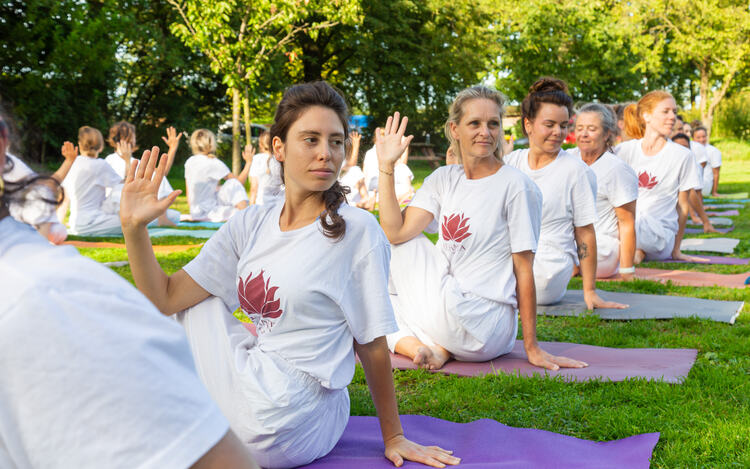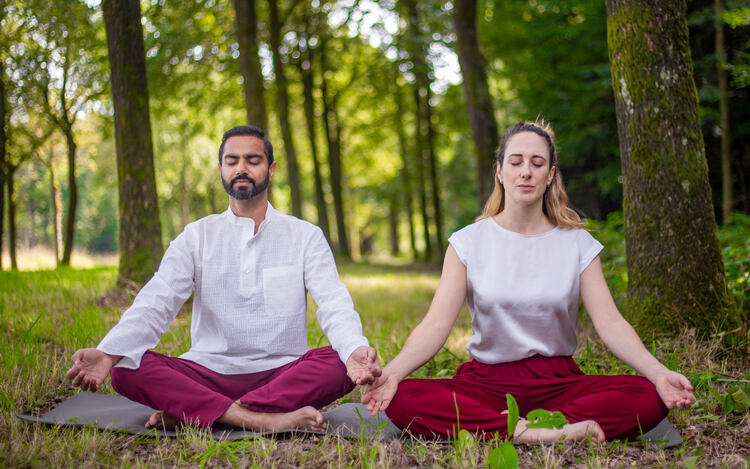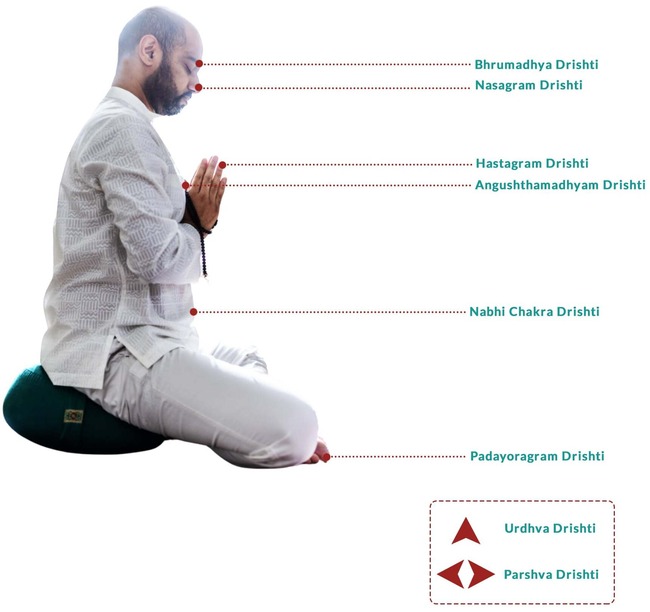In today's technology-driven world, finding focus is a challenge we know all too well. Think about it—when was the last time you were able to clear your mind and fully concentrate on one thing? Whether wondering what to make for dinner while practicing yoga, or fixating on that unbelievable TikTok hack in your work meeting, our minds are constantly being tugged in multiple directions. So, how do we deepen our focus in yoga and life?
The ancient yogic technique, Drishti, offers a simple way to silence chaotic thoughts and anchor the mind in the present. This form of yoga gazing helps you access a more focused state not just in yoga, but in daily life. Read on to discover the real meaning of Drishti, how to practice it, and why this technique is so much more than just staring.
What Is Drishti?

Drishti is a technique in yoga and meditation that involves focusing your attention or gaze on a specific point. In practice, the Drishti gaze can be on any fixed point; a spot on the floor, the tip of your nose, or even your third eye. By focusing on a single point, your attention follows, and you naturally improve your concentration, physical balance, and alignment.
There are two main categories of Drishti in yoga:
Bahaya Drishti (external yoga gaze):
Bahaya Drishti simply means gazing at an actual external object around you, like a spot on the wall or your big toe. In Ashtanga Yoga, there are 9 Drishti points used in various postures to maintain balance and alignment while improving focus.
Antar Drishti (internal yoga gaze):
This is a more advanced form of focus in yoga that involves visualizing an object in your mind's eye (Ajna Chakra), such as a candle flame, Om symbol, or spiritual figure. With practice, internal gazing can transcend the distracted states of mind and increase inner awareness.
What Is the Meaning of Drishti?
Drishti is a Sanskrit term that means "view," "gaze," or "point of focus". Yoga philosophy defines Drishti as a tool which facilitates the journey from focused concentration (Dharana) to a deeper, meditative state (Dhyana) in yoga practice. However, the term Drishti can have different meanings depending on your chosen path and intention.
In physical yoga asana practice, Drishti means the focused gaze on a fixed point for balance and proper alignment. For example, gazing at your fingertips in Utthita Trikonasana (Extended Triangle Pose) helps keep your head and torso in proper alignment. But Drishti can also refer to our internal “view”.
This focused yoga gazing can be a deeply spiritual practice that takes you inward to witness the inner state beyond external distractions, ego, and worldly illusions. With practice, it can lead to profound clarity and insight about your true nature and purpose. You see the universe for what it is, and inch closer to the ultimate state of mind, or Patanjali's Eighth Limb of Yoga: Samadhi.
How to Deepen Your Focus in Meditation & Yoga with Drishti
Drishti in Meditation

Our minds tend to jump around like a monkey when we meditate. One second, we're counting breaths, the next we’re thinking about our shopping list. Drishti in meditation reins in the restless Kshipta state, focus it on a single point, and cultivate deep focus and introspection.
This yoga gaze helps us ride the waves of distraction with more balance and inner calm. We learn to observe our thoughts without getting tangled up in them, and inner stillness comes more naturally. Here is a simple way you can use Drishti in your meditation practice.
Step 1: Find a Focal Point
Before you settle into a meditation position, choose a single point to focus on during your practice. This could be your breath, a candle, yantra, or even your third eye center. Personally, I like to chant "Om" with a string of Japa beads between my fingers. Give this method a try with me in this easy guided Japa meditation.
Step 2: Gaze Gently
If you have an external focal point, gaze at it with soft, relaxed eyes. Avoid straining and breathe steadily as you gaze, feeling a sense of calm and peace begin to wash over.
If you are focusing your attention inward, you can close your eyes and concentrate on the location of your Ajna Chakra, or perhaps visualize the Om symbol in your mind.
Step 3: Focus Inward
Tune out any distractions and focus your full attention on the chosen focal point. You will be challenged by distracting thoughts and your senses will begin to heighten. If the mind wanders, gently return to the present moment and your point of focus.
Step 4: Deepen the Gaze
Once you have established your Drishti gaze, see if you can deepen it. Softly release any subtle tension in the eyes, relax the forehead, and take deep natural breaths to calm the nervous system. Narrow the field of attention around the focal point, as if looking through a long tunnel. Let go of any external desires or ego, and feel yourself absorb into the present moment.
With regular practice, Drishti can help you transcend from the Ekagra (one-pointed) mind to the Niruddha (completely controlled) mind. In this state, you can view the world more clearly and develop a deep sense of self-awareness.

Discover yoga philosophy principles to boost your happiness
Get free access to a life-changing series of 6 webinars with Arhanta Yoga founder Ram Jain
Drishti in Yoga
Drishti benefits your yoga practice in many ways. On a physical level, the yoga gaze helps to stabilize challenging balancing postures and improve alignment by giving you a steady focal point to synchronize the mind and body. Beyond the physical, Drishti draws the senses inward which stimulates inner awareness and mindfulness both on and off the mat.
Ashtanga Yoga outlines 9 Drishti points you can use to deepen your focus, maintain alignment, and turn your attention inward during asana practice.

1. Bhrumadhya Drishti (between the eyebrows)
This yoga focal point is situated between the eyebrows, at the third eye center. We commonly use the Bhrumadhya Drishti during meditation to bring the attention inward and awaken Kundalini energy.
2. Nasagram Drishti (tip of the nose)
Located at the tip of the nose, we use the Nasagram Drishti in poses like Four-limbed Plank Pose (Chaturanga Dandasana) and Upward-facing Dog Pose (Urdhva Mukha Svanasana) to deepen concentration and stabilize balance.
3. Nabhi Chakra Drishti (navel)
This yoga Drishti brings the focus to the naval, where your Manipura Chakra is located. In poses like Downward-facing Dog (Adho Mukha Svanasana), we can use this focus point to maintain proper alignment and deepen the pose.
4. Hastagram Drishti (hand)
The Hastagram Drishti is situated on the hands and fingertips. In arm balances and standing poses, gaze at the hand in your line of sight for a deeper stretch without toppling over.
5. Angushthamadhyam Drishti (thumbs)
We gaze at the thumbs in Angushthamadhyam. Use this focus point in the Warrior Poses to bring an uplifting quality and intention to the posture. It is also used in Upward Salute (Urdhva Hastasana) and Eagle Pose (Garudasana).
6. Padayoragram Drishti (toes)
Located at the toes, the Padayoragram Drishti is used in most forward bends for better balance and stability during the fold as well as to enhance focus.
7. Parshva Drishti (far to the right)
In Parshva Drishti, we gaze right to lengthen sideways. This is a great focus point to use in yoga twists like Half Lord-of-the-Fishes Pose (Ardha Matsyendrasana).
8. Parshva Drishti (far to the left)
In the twists mentioned above, you will alternate sides and gaze to the far left for a balanced stretch.
9. Urdhva Drishti (up to the sky)
Lastly, we lift our gaze upward to the sky and awareness into infinity with Urdhva Drishti. This yoga focus point is usually practiced in poses like Warrior 1 (Virabhadrasana 1) and Half Moon Pose (Ardha Chandrasana) to maintain proper alignment and steady balance.
Benefits of Drishti
Learning how to find focus in yoga can benefit your life beyond just better balance. Originally used to prepare the mind for meditation, single-pointed gazing has developed into an enriching technique to improve alignment, improve balance, and tap into deeper layers of the Self. Here are some benefits yoga gazing can bring:
Strengthens Focus
Just like doing bicep curls at the gym builds arm strength, the practice of gazing steadily at one spot during yoga or meditation trains your mind to focus more deeply. With a focused mind, you can direct your energy and awareness more skillfully. Activities that once seemed challenging, like holding a balancing pose or sitting still in meditation start to feel more natural and effortless.
Improves Postural Alignment
Drishti is an excellent guide for proper posture in yoga poses. When you give your eyes a steady gazing point, it sends a signal to your muscles to align the rest of your body around that focal point.
For example, if you tend to slump in Warrior II, gaze directly at your front fingertips. Your eyes lining up with your fingertips will activate your back and shoulders to lift properly. Or if you wobble in Tree Pose, focus on a spot on the floor to anchor your stance. Over time, those proprioceptive signals become ingrained patterns that adjust your body into proper form.
Develops Mindfulness & Self-Awareness
The constant chatter and distraction in your mind can take you out of the present moment and leave you stressed and frustrated after only a few minutes alone. Drishti helps get your attention back where you want it.
By drawing the senses inward and limiting external stimuli, fixed point gazing develops a state of inner calm. Over time, this helps you tune into subtle sensations in your body and rising emotions without judgment. You gain insight about your inner world and develop a new-found sense of Self.
Final Thought
Drishti in yoga is much more than mastering a perfectly balanced pose or sharp focus. When you direct your gaze with intention during practice, you unlock deep concentration and spark a powerful connection between your mind and body. With time, this simple yoga gaze can open a gateway that leads you to inner peace and your true Self.

Discover yoga philosophy principles to boost your happiness
Get free access to a life-changing series of 6 webinars with Arhanta Yoga founder Ram Jain

